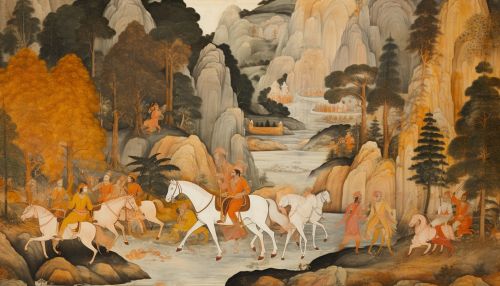Indian epics
Introduction
The Indian subcontinent has been the birthplace of some of the world's most enduring epics. These literary works have shaped the cultural, religious, and social landscape of the region and continue to influence millions of people worldwide. The most renowned among these are the Mahabharata and the Ramayana, both of which are considered to be the pillars of Indian literature.


The Mahabharata
The Mahabharata, often referred to as the "fifth Veda", is one of the two major Sanskrit epics of ancient India. It is an epic narrative of the Kurukshetra War and the fates of the Kaurava and the Pandava princes. The Mahabharata is the longest known epic poem and has been described as "the longest poem ever written". Its longest version consists of over 100,000 shloka or over 200,000 individual verse lines, and long prose passages.
Composition and Structure
Traditionally, the authorship of the Mahabharata is attributed to Vyasa. The text is structured as a frame story encompassing an extensive range of smaller stories and fables. These narratives are often didactic, embodying moral and philosophical principles. The Bhagavad Gita, a sacred text of the Hindu religion, is part of this epic and is considered one of the most important texts in the history of literature, philosophy, and spirituality.
Themes and Characters
The Mahabharata addresses the fundamental questions of life and morality, exploring themes such as duty (dharma), righteousness, and the paths to salvation. Its characters, including Arjuna, Krishna, Draupadi, and Duryodhana, are deeply complex, embodying a range of human emotions and dilemmas.
The Ramayana
The Ramayana is another ancient Indian epic attributed to the sage Valmiki. It narrates the life of Rama, the seventh avatar of the Hindu god Vishnu. The epic explores themes of dharma, devotion, honor, and the virtues of the ideal king, ideal servant, ideal brother, ideal wife, and ideal enemy.
Composition and Structure
The Ramayana is composed in Sanskrit and consists of about 24,000 verses divided into seven books. The narrative follows the journey of Rama as he embarks on a quest to rescue his wife Sita from the demon king Ravana.
Themes and Characters
The Ramayana explores the concept of dharma and presents models of heroism, service, and devotion. Its characters, including Rama, Sita, Hanuman, and Ravana, are integral to the cultural consciousness of the Indian subcontinent.
Other Indian Epics
In addition to the Mahabharata and the Ramayana, there are several other lesser-known Indian epics. These include the Puranas, a genre of important Hindu, Jain and Buddhist scriptures, and the Jataka tales, stories about the previous lives of the Buddha, in both human and animal form.
Influence and Legacy
The Indian epics have had a profound influence on Indian culture, shaping its art, literature, philosophy, and social structure. They continue to be retold and reinterpreted in different languages and artistic forms, including drama, dance, film, and television.
